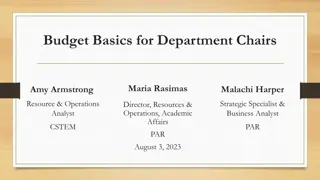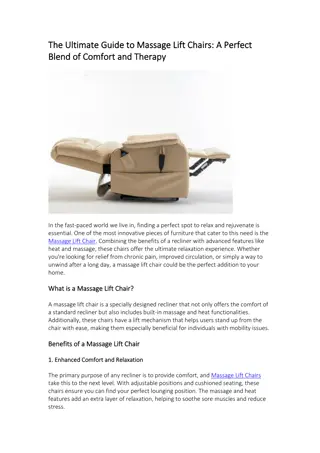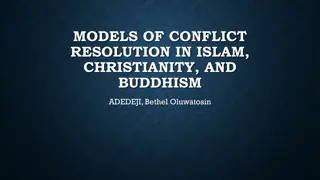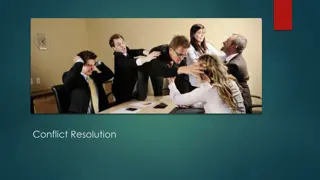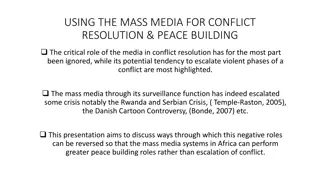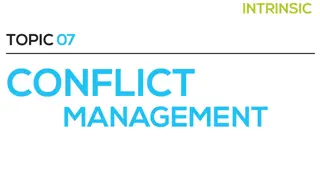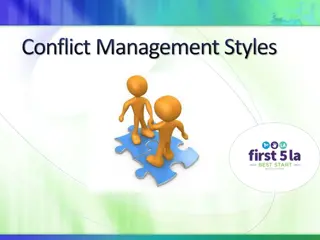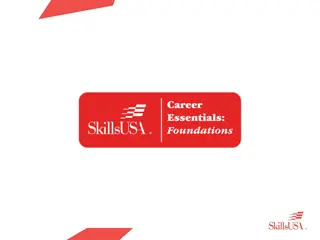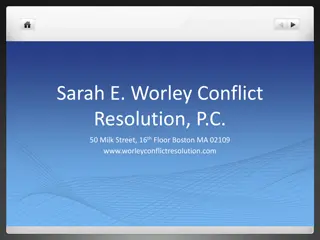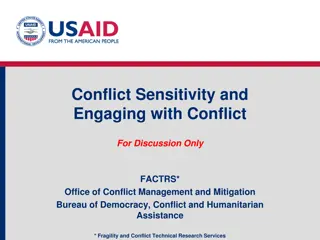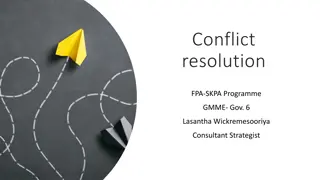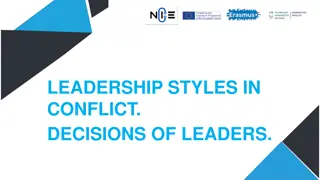Effective Conflict Resolution Strategies for Department Chairs
Dealing with conflicts gracefully is key in a chair role. Prevention through transparency and communication is vital. Proactive conflict resolution benefits all involved. Setting clear expectations, involving committees when needed, and protecting oneself are vital components. Addressing scenarios like staff complaints, unresponsive faculty, and abusive behavior requires tailored responses. Effective conflict management nurtures a positive departmental climate.
Download Presentation

Please find below an Image/Link to download the presentation.
The content on the website is provided AS IS for your information and personal use only. It may not be sold, licensed, or shared on other websites without obtaining consent from the author. Download presentation by click this link. If you encounter any issues during the download, it is possible that the publisher has removed the file from their server.
E N D
Presentation Transcript
Difficult Conversations and the opportunity of conflict Kevin Knudson, Professor and Chair of the Mathematics department, University of Florida. Gloria Mar Beffa, Professor of Mathematics, former chair of Math and Academic Associate Dean for the Sciences, College of Letters and Science, UW-Madison.
CONFLICT IS OFTEN AN OPPORTUNITY FOR LEARNING, CONNECTING, GAINING INSIGHT AND RESOLVING PROBLEMS Life will always have conflict. The idea is not to live life without conflict. The idea is to deal with conflict gracefully The best way to deal with conflict is not to have them! Prevention is the most effective. Transparency and communication are the best preventive measures for conflict. Conflicts are best resolved in a timely and proactive manner. Being proactive benefits YOU, and the department. Listening is the #1 job of a chair. Be curious!! Don t draw quick conclusions, ask questions to understand and take your time if possible. Always deescalate tensions, have ready some made phrase you can use during tense situations. Once you agree to do something follow through or keep the person updated. Be aware of your own prejudices based on past experiences, you are not immune, be self-aware. Zen Proverb 1. 2. 3. 4. 5. 6.
QUESTIONS FOR DISCUSSION What are the boundaries of what you handle as a chair? At what point do you reach out to resources, to HR or to higher administration within your College or division? 1. What issues are there in your department that you are concerned about, or are anticipating dealing with in your role as chair? 2. Please, discuss.
GOOD PRACTICE Review policies and processes for most major tasks (teaching distribution and load, service distribution and load, hiring, salary, awards nomination, etc), be sure everyone knows them and agree. Implement them in a transparent and consistent way. Discuss climate, including inclusion and sexual harassment. Set clear departmental expectations, remind everyone of key factors and refer the faculty to University policy every year. Have a clear and well publicized grievance/reporting process. When the situation is very difficult involve committees if possible. Ditto if it is personal or if it affects you emotionally. Protect yourself. Set realistic expectation, in writing so as to avoid misunderstandings. After a significant meeting, write down and share a summary and a list of next steps to be sure everyone is on the same page. 1. 2. 3. 4. 5. What else?
SCENARIOS-1 1. A support staff comes to you complaining about a perceived inequality regarding compensation. How do you respond? 2. A graduate student comes to you with a complaint about a faculty member who does not respond to e-mails or requests to meet. How do you address this? 3. A faculty member has been sending abusive emails to staff in various offices around campus related to a research. It is jeopardizing the department s relationship with these offices. How do you respond? Please discuss, and notice that different contexts might require different responses
SCENARIOS-2 A faculty member was intoxicated at an after work gathering with colleagues and she insulted another faculty member. This caused friction between the two and others in the department want you to address it. What actions do you take? 1. The Executive Committee has taken a somehow controversial decision that you and a majority favor. A small, but vocal minority want to take the department in a different direction long-term. How do you handle this situation? 2. Please discuss. Once more, context is crucial and it is worth to consider different situations when the reaction will also be different
SERIOUS MISCONDUCT: PROFESSIONAL MISCONDUCT, SEXUAL HARASSMENT AND OTHERS By the numbers* Nonconsensual sexual contact by physical force or inability to consent increased from 2015 to 2019 by 3% for undergraduate women (to over 26%); 2.4% for graduate and professional women (to over 10%); and 1.4% for undergraduate men (to around 7%). The change for TGQN and graduate/professional men was not statistically significant. 1. Among undergraduate TGQN students: 65.1% reported experiencing harassing behavior since first enrolling at the school. 21.5% with partners reported intimate partner violence (IPV) and 15.2% stalking. Among undergraduate women 59.2, 14.1 and 10.0% experienced harassment, IPV and stalking, respectively. 2. Overall, 18.9% of students reported sexually harassing behavior that either interfered with their academic or professional performance , limited their ability to participate in an academic program or created an intimidating, hostile or offensive social, academic or work environment . 3. Among graduate and professional women who were sexually harassed, 24.0% were by a faculty member or instructor. For undergraduate women 5.5% were, men 4.3%; for graduate and professional men 18.2%. 4. *2019 Association of American Universities (AAU) Campus Climate Survey on Sexual Assault and Misconduct.
HOW TO ADDRESS SERIOUS MISCONDUCT 1. Each University has a different process for professional misconduct. It is not up to you to be the judge and decide the validity of these cases. The University ought to have processes that do that for you. 2. Many Universities have mandatory reporting of title IX cases, scientific misconduct and possibly harassing and intimidating behavior. Learn if that is the case. 3. When dealing with and communicating about serious misconduct, follow the lead of the experts. Your HR, title IX and the Scientific Integrity offices know how to deal with them effectively. What else?
SCENARIOS-3 Assume a colleague tells you that there are rumors that another colleague is having an affair with her graduate student. What actions should you take? You just learned that a graduate student just moved in with one of his undergraduate students. What do you need to do? You receive an e-mail from a mathematician explaining that someone you are trying to hire is claiming results that are not his or her, but are the e-mail writer s. The person claims that he or she has not been given acknowledgement of his/her contributions. What should you do? Please discuss.
REDUCING THE IMPACT ON A DEPARTMENT Sometimes the misconduct is serious enough that a department can split, groups can take sides and the community can be seriously damaged. 1. Rumors are toxic. Address rumors as they appear, publicly if appropriate. 2. Work with the administration to learn how much you can disclose to the department s community and to whom. Be fair when disclosing information. 3. Work with hypotheticals: explain to everyone the official process and how it works, including standard actions by the administration in different types of cases. 4. Look at the future: discuss how to improve the climate, plan new safeguards and involve the affected community in this process.
RESOURCES Be sure you know the resources you have available at your own institution! Typically: HR, College, Scientific Integrity officer, title IX, Ombudsmen. Working with the Self-Absorbed: How to Handle Narcissistic Personalities on the Job by Nina Brown 1. The College Administrator Survival Guide by C. K. Gunsalus 2. How to Have Difficult Conversations When You Don t Like Conflict by Joel Garfinkle, Harvard Business Review, May 24, 2017 3. 2019 Association of American Universities (AAU) Campus Climate Survey on Sexual Assault and Misconduct. https://www.aau.edu/key-issues/campus-climate-and- safety/aau-campus-climate-survey-2019 4. Thanks!!
Participant Institutions AAU 2019 report Boston University Brown University California Institute of Technology Carnegie Mellon University Case Western Reserve University Harvard University Iowa State University Massachusetts Institute of Technology Northwestern University Rice University Stanford University Texas A&M University The Johns Hopkins University The Ohio State University The University of Arizona The University of Chicago The University of Kansas The University of North Carolina at Chapel Hill The University of Wisconsin-Madison University of Florida University of Michigan University of Minnesota, Twin Cities University of Missouri University of Oregon University of Pennsylvania University of Pittsburgh University of Rochester University of Southern California University of Virginia Vanderbilt University Washington University in St. Louis Yale University

 undefined
undefined








